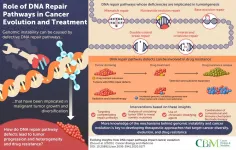(Press-News.org) Ithaca, N.Y. - At a glacier near the South Pole, earth scientists have found evidence of a quiet, slow-motion fault slip that triggers strong, fast-slip earthquakes many miles away, according to Cornell University research published in Science Advances.
During an earthquake, a fast slip happens when energy builds up underground and is released quickly along a fault. Blocks of earth rapidly slide against one another.
However, at an Antarctic glacier called Whillans Ice Plain, the earth scientists show that "slow slips" precede dozens of large magnitude 7 earthquakes. "We found that there is almost always a precursory 'slow slip' before an earthquake," said lead author Grace Barcheck, research associate in Earth and Atmospheric Sciences at Cornell University.
Barcheck said that these slow-slip precursors - occurring as far as 20 miles away from the epicenter - are directly involved in starting the earthquake. "These slow slips are remarkably common," she said, "and they migrate toward where the fast earthquake slip starts."
Observations before several large tsunami-generating magnitude 8 and 9 earthquakes on subduction zone faults suggest a similar process may have occurred, according to Patrick Fulton, assistant professor and Croll Sesquicentennial Fellow in the Department of Earth and Atmospheric Sciences.
As these faults are mostly offshore and deep underwater, and because it is difficult to know when or where a large earthquake will occur, the start of large earthquakes is generally hard to observe.
To overcome these challenges, the scientists placed GPS sensors above an icy glacial fault at Whillans Ice Plain, where large magnitude 7 earthquakes occur nearly twice a day over a 60-mile-wide area of the glacier.
Within a period of two months in 2014, the group captured 75 earthquakes at the bottom of the Antarctic glacier. Data from GPS stations indicated that 73 - or 96% - of the 75 earthquakes showed a period of precursory slow motion.
The data from the GPS tracking stations and surface seismometers allowed the team to identify how the slow precursory slip triggers the fast earthquake slip.
"Our group was a little surprised to see so many precursors," Barcheck said.
"In some cases, we can actually see the migration of the earthquake precursor towards where the earthquake begins."
"Before we pored over the data, I thought that if we saw any precursors before the earthquakes, they would be rare and in the same place as the earthquake epicenter," she said. "Instead, we found many slow-slip precursors - starting miles from the epicenters and migrating across the fault."
INFORMATION:
In addition to Barcheck and Fulton, co-authors on the research, "Migratory Earthquake Precursors are Dominant on an Ice Stream Fault," were Emily Brodsky, professor, Department of Earth and Planetary Sciences, University of California, Santa Cruz, formerly a visiting professor at Cornell; Matt King, professor, Geography and Spatial Sciences, University of Tasmania, Hobart, Tasmania; Matthew Siegfried, Department of Geophysics, Colorado School of Mines, Golden, Colorado; and Slawek Tulaczyk, professor, Department of Earth and Planetary Sciences, University of California, Santa Cruz.
Field work and analysis for this research was supported by the National Science Foundation.
WHAT
Gliomas are common brain tumors that comprise about one third of all cancers of the nervous system. In a study funded by the National Institutes of Health (NIH), researchers tested a novel combination treatment approach on mice with tumors with characteristics similar to human astrocytomas--a type of slow-growing glioma--and found tumor regression in 60 percent of the mice treated. These encouraging results, published in the Journal of Clinical Investigation, could be the first step toward developing a treatment for this type of brain cancer.
Led by senior authors Maria Castro, Ph.D. and Pedro Lowenstein, M.D., Ph.D. along with a team of researchers at the University of Michigan Rogel Cancer Centerb in Ann Arbor specifically ...
High levels of public support for strict measures to control COVID-19 during the first wave of the pandemic did not reflect high levels of public trust in the UK government's honesty, transparency or motives, suggests a new study published in PLOS One.
The 'mixed-methods' project, a collaboration between the London School of Hygiene & Tropical Medicine (LSHTM) and University College London (UCL), involved collecting data from more than 9,000 adults living in the UK using an online survey.
It found that during the first wave of COVID-19 (April 2020) 95% of participants were in support of the government having powers to enforce behaviour change. However, only around half (52%) thought that the government was actually doing a good job of controlling COVID-19. Even fewer (36%) thought ...
New research has found that a group of genes that reduces the risk of developing severe COVID-19 by around 20% is inherited from Neanderthals
These genes, located on chromosome 12, code for enzymes that play a vital role in helping cells destroy the genomes of invading viruses
The study suggests that enzymes produced by the Neanderthal variant of these genes are more efficient which helps protect against severe COVID-19
This genetic variant was passed to humans around 60,000 years ago via interbreeding between modern humans and Neanderthals
The genetic variant has increased in frequency over the last millennium and is now found ...
Researchers from Skoltech and their colleagues have demonstrated that nanoengineered biodegradable microcapsules can guide the development of hippocampal neurons in an in vitro experiment. The microcapsules deliver nerve growth factor, a peptide necessary for neuron growth. The paper describing this work was published in the journal Pharmaceutics.
Many neurodegenerative conditions that can lead to severe disorders are associated with depleted levels of growth factors in the brain - neuropeptides that help neurons grow, proliferate and survive. Some clinical studies of Alzheimer's and Parkinson's diseases have shown that delivering these growth factors to specific degenerating neurons can have a therapeutic effect. ...
Scientists from the National Renewable Energy Laboratory (NREL) have developed a simple way to better evaluate the potential of novel materials to store or release heat on demand in your home, office, or other building in a way that more efficiently manages the building's energy use.
Their work, featured in Nature Energy, proposes a new design method that could make the process of heating and cooling buildings more manageable, less expensive, more efficient, and better prepared to flexibly manage power from renewable energy sources that do not always deliver ...
Last year, researchers at Karolinska Institutet in Sweden and the Max Planck Institute for Evolutionary Anthropology in Leipzig, Germany showed that a major genetic risk factor for severe COVID-19 is inherited from Neandertals. Now the same researchers show, in a study published in PNAS, that Neandertals also contributed a protective variant. Half of all people outside Africa carry a Neandertal gene variant that reduces the risk of needing intensive care for COVID-19 by 20 percent.
Some people become seriously ill when infected with SARS-CoV-2 while others get only mild or no symptoms. In addition to ...
How do plants build resilience? An international research team led by the University of Göttingen studied the molecular mechanisms of the plant immune system. They were able to show a connection between a relatively unknown gene and resistance to pathogens. The results of the study were published in the journal The Plant Cell.
Scientists from "PRoTECT" - Plant Responses To Eliminate Critical Threats - investigated the molecular mechanisms of the immune system of a small flowering plant known as thale cress (Arabidopsis thaliana). PRoTECT ...
The ongoing health disaster of the past 12 months has exposed the crises facing nursing homes in Canada and the United States and the struggles of the staff working in them.
Writing in the Journal of Comparative Policy Analysis: Research and Practice, PhD student Daniel Dickson, his supervisor Patrik Marier, professor of political science, and co-author Robert Henry Cox of the University of South Carolina perform a comparative analysis of those workers' experiences. In it, they look at Quebec (including those at government-run CHSLDs), British Columbia, Washington State and Ohio ...
Hamilton, ON (February 16, 2021) - A McMaster stem cell research team has made an important early step in developing a new class of therapeutics for patients with a deadly blood cancer.
The team has discovered that for acute myeloid leukemia (AML) patients, there is a dopamine receptor pathway that becomes abnormally activated in the cancer stem cells. This inspired the clinical investigation of a dopamine receptor-inhibiting drug thioridazine as a new therapy for patients, and their focus on adult AML has revealed encouraging results.
AML is a particularly deadly cancer that starts with a DNA mutation in the blood stem cells of the bone marrow that produce too many infection-fighting white blood cells. According ...
The ongoing fight of science against cancer has made great strides, but cancer cells have not made it easy. The complexity of cancer cells and their adaptive evolutionary nature complicate the search for effective cures. Multiple DNA repair pathways in healthy cells typically work to rectify DNA damages caused by sources within the organism, like spontaneous DNA mutations, or from outside, like ultraviolet radiation.
But what happens when these pathways malfunction? It is known that deficiencies in these pathways increase the instability of the genes, and this causes cancer to develop. Therefore, detailed knowledge of how DNA repair pathways participate in this process is crucial for tracking tumor progression, understanding the emergence of drug ...




